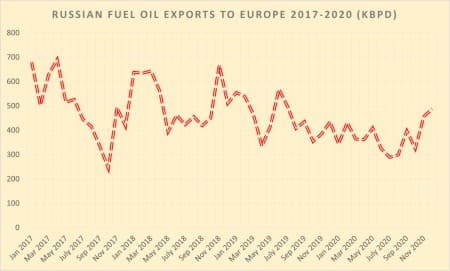We have already written about one of the most paradoxical developments of the US-Russia energy relationship, namely that American refiners have become the number one buyer of Russia’s fuel oil production. With Venezuelan crude squeezed out from the American market, Iranian exports kept at bay by means of a similar set of sanctions, Mexico remaining in decline and even acquiescing to a OPEC+ production cut, Russian fuel oil remains one of the very few USGC feedstocks that is still not too pricey and available in sufficient volumes. However, the winter months of the 2020/2021 season have so far witnessed a sharp decline in Russian fuel oil exports towards the United States and a quite tangible hike in their supplies towards Europe. Could that put the peculiar US-Russia HSFO love story to an end?
Supplies of Russian fuel oil to Europe have averaged roughly 500kbpd in the past 5 years, although since 2019 the trend started to gradually drop increasingly lower – this year (i.e. 2020) they have been around 375kbpd, all this with November-December being significantly better than the months preceding them. The reorientation of erstwhile Europe-bound exports towards the United States has in many ways saved Russia’s Northwestern refineries, as not many other market outlets would be remaining in a rapidly de-sulphurizing environment. With a fair share of European demand out, US refiners have availed themselves of relatively cheap HSFO as a secondary coker feedstock, seemingly to the mutual benefit of both. Yet from November 2020 onwards, Russian exports of fuel oil have started to move back to their erstwhile allocation as US-bound cargoes are becoming rarer and exports to Europe have been on the surge.
Graph 1. Russian Fuel Oil Exports to Europe in 2017-2020 (‘000 barrels per day).

Source: Thomson Reuters.
There remain quite objective reasons for Russian fuel oil supplies to drop, too. First and foremost, the hurricane shutdowns have left their imprint on November refining – refining runs in mid-November dropped by some 15% within the timeframe of less than 2 weeks, spurred by Hurricane Zeta and COVID-19 ramifications. Second, seasonal maintenance might also be part of the jigsaw puzzle, with as much as 2.5 mbpd worth of refining capacity taken offstream during the last 2 months of 2020. Third, real-time statistics might be a bit skewed in that oftentimes the source of the HSFO is showing the site of the ship-to-ship transfer, meaning that some of the supplies that officially come from Skaw or Malta might be in fact of Russian origin. Related: Oil Rises As Market Awaits OPEC+ Production Decision
Europe’s ascent might be underpinned by some statistical peculiarities, too, as the main market for High Sulphur Fuel oil supplies in December 2020 was the Middle East, not Europe. In terms of European exports most of Russia’s fuel oil, which is generally produced in the Baltic area, is being exported to the Amsterdam-Rotterdam-Antwerp (ARA) area, from where it could easily move further towards markets like Saudi Arabia. And so it did, last month European fuel oil exports towards the Middle East have surged 300% month-on-month to October, with more than a million tons of HSFO moving eastwards. The trend surged even higher in December 2020 when a total of 7 MMbbls of fuel oil from Europe reached Middle Eastern customers, across 19 deliveries.
Such a healthy demand for HSFO has boosted Russia’s downstream prospects in November-December 2020, a season that cannot be considered as being peak periods. If one is to look at the exported volumes, it becomes evident that Russia’s main HSFO port in Ust-Luga has coped much better with this year’s demand slump than regional competitors. Set for a year-end fuel oil export tally of 15.5 million tons, Ust-Luga only dropped some 2% year-on-year whilst the likes of Klaipeda, Riga, Sillamae and others have witnessed double-digit decreases. Fuel oil exports were one of the few products that more or less managed to maintain their 2019 standings (along with naphtha and gasoline), including a rather unexpected HSFO surge in the Far East in May-July 2020, more than doubling the annual tally of Nakhodka loadings.
Graph 2. Russian Fuel Oil Exports to the United States in 2017-2020 (‘000 barrels per day).

Source: Thomson Reuters.
As significant as the drop in Russian HSFO exports to the United States might seem at first glance, it need not be a sign of an impending decline. Demand for HSFO is partially subject to seasonability as its usage in the power generation sector plummets in the winter as air-conditioning usage decreases. Overall high-sulfur fuel oil would still be a great feedstock for USGC refiners, especially considering that many of them invested in desulfurization capacity over the past couple of years. Therefore, maintaining high Russian HSFO exports will largely depend on the saturation of the Middle Eastern market – further instances of high Saudi demand or of increased scrubber usage in the Singapore area will divert volumes away from the Gulf Coast.
ADVERTISEMENT
By Viktor Katona for Oilprice.com
More Top Reads From Oilprice.com:
- A Silver Lining For Kazakhstan Oil In 2020
- The Middle East Needs To Wake Up To Renewables
- The Russian Energy Giant Mining Bitcoin With Virtually Free Energy


















